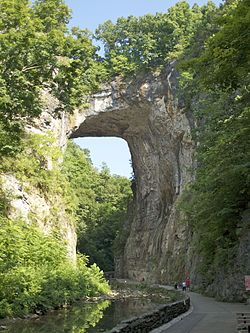Natural Bridge (Virginia)
|
Natural Bridge
|
|

The Natural Bridge
|
|
| Nearest city | Natural Bridge, Virginia |
|---|---|
| Coordinates | 37°37′39″N 79°32′43″W / 37.62750°N 79.54528°WCoordinates: 37°37′39″N 79°32′43″W / 37.62750°N 79.54528°W |
| Part of | Natural Bridge Historic District (#15001047) |
| NRHP Reference # | 97001401 |
| Significant dates | |
| Added to NRHP | November 18, 1997 |
| Designated NHL | August 6, 1998 |
Natural Bridge is a geological formation in Rockbridge County, Virginia, in which Cedar Creek (a small tributary of the James River) has carved out a gorge in the mountainous limestone terrain, forming a natural arch 215 feet (66 m) high with a span of 90 feet (27 m). It consists of horizontal limestone strata, and is the remains of the roof of a cave or tunnel through which the creek once flowed. Natural Bridge has been designated a Virginia Historic Landmark and a National Historic Landmark. Since 2016, Natural Bridge has been managed by the Commonwealth of Virginia as part of Natural Bridge State Park.
Rocks in the area are limestones and dolomites from the Ordovician Period, which implies deposition about 470 million years ago. The carbonates of the Natural Bridge occur within the Chepultepec Formation, making the buttress of the bridge, and the Beekmantown Formation, deposited conformably over the Chepultepec and comprising the span and the upper part of the bridge.Strata at Natural Bridge are close to horizontal, in contrast with dipping and folded beds as close as 300 feet (91 m) away along Highway 11, which points to the fact that structurally the rocks making the Natural Bridge are the bottom part of a syncline.
The process of formation of the bridge is less certain, but the ideas proposed by different individuals have in common the importance of three elements: The southeast dipping of the strata, the capability of water to slowly dissolve carbonates and the existence of numerous fractures. Edgard W. Spencer has provided a summary of the most respected interpretations and produced the presently most widely accepted hypothesis. According to him, the Natural Bridge would be the remnant of an underground river tunnel that diverted water to the south. Initially, the underground river started capturing water from the Poague Run about two miles (3.2 km) to the north, contributing to enlarge the incipient Cedar Creek drainage basin. Over time, through weathering and erosion, the underground river collapsed and disappeared almost completely, the Natural Bridge being the only surviving relic of the roof of the ancient underground river. The creek's larger flow contributed to form the present day gorge, significantly increasing the distance from the bottom of the water flow to the roof of the underground channel. Today, the "Lost River", about one-half mile (0.80 km) upstream from the Natural Bridge, is a vivid example supporting the hypothesis of the underground river. Water from the side of the gorge flows into the Cedar Creek, similarly as the ancestral Cedar Creek underground river allegedly flowed into the Cascade Creek, presently entering the Cedar Creek approximately 500 feet (150 m) below the Natural Bridge.
...
Wikipedia

